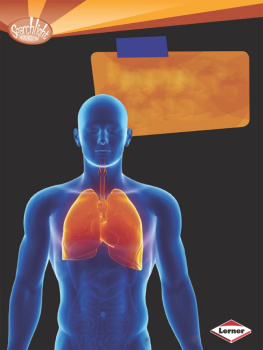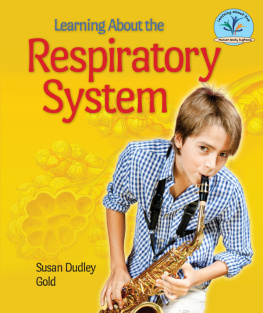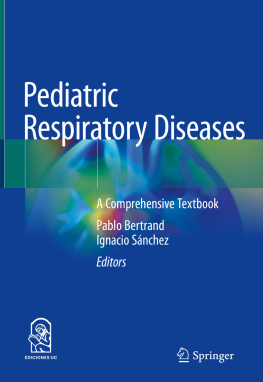Acknowledgments
Anna RubaK/ShutterStock, Inc.
I am honored and privileged to be able to complete the work of Anthony James Linz, DO, MPH, the original author of this text. It was his love of pulmonary medicine and teaching respiratory care students that led him to proposing this book and authoring several of the chapters before his death. I share Dr. Linzs love of teaching and vision to have a pulmonary disease textbook that embodies a student-centered pedagogical approach to pulmonary disease.
Also, a project of this magnitude is never completed without assistance. I would like to thank all the contributors, Hossein Gharanfoli, Donna (De De) Gardner, Ray Lenius, Sharon Connelly-Merdian, Nicole Smith, Marnni Elaine Hutchins, Jeffery Ruiter, Charley Starnes, Amanda Dexter, and Daniel Fisher, for their hard work and dedication. Thank you to the ancillary contributor, Jean Newberry, for her ability to take my thoughts and put them into action. Finally, a special thanks to Cathy Esperti and Rachael Souza for giving me the opportunity and assistance to make this book a reality.
Sindee Kalminson Karpel, MPA, RRT, AE-C
About the Author
Anna RubaK/ShutterStock, Inc.
Sindee Kalminson Karpel , MPA, RRT, AE-C , has been a respiratory therapist since 1980 and is currently professor of cardiopulmonary sciences and respiratory care and chair of the Bachelor of Science completion program in cardiopulmonary sciences in the School of Health Professions at Florida SouthWestern State College in Fort Myers, Florida. She is the author of several textbook ancillaries, continuing education books, and peer-reviewed articles. Sindee served on the founding Board of Directors of the National Asthma Education Certification Board and on the Board of Directors of the New York State Society for Respiratory Care and is currently on the Board of Directors of the Lambda Beta Society. She is the recipient of the 2003 NYSSRC Samuel Runyon Memorial Award, the 1990 NYSSRC Practitioner of the Year Award, and the 1988 NYSSRC-SEC Award for Excellence in Respiratory Care.
Sindee was born and raised in New York City, New York. She received her bachelor of arts degree in anthropology from Queens College of the City University of New York (1974), a 2-year certificate in Respiratory Care from New York University Medical CenterBellevue Hospital (1980), and a Master of Public Administration degree in healthcare administration from the C.W. Post Campus of Long Island University (1986). Before relocating to Florida, Sindee was associate professor of allied health sciences at the Borough of Manhattan Community College of the City University of New York, where she taught for 10 years. She began her career in respiratory care at Queens Hospital Center in New York, where she was promoted from staff respiratory therapist to day supervisor to assistant director. Sindee also worked as adjunct faculty of the respiratory care program at the Borough of Manhattan Community College from 1982 to 1993. She was also assistant director of respiratory care at Long Island Jewish Medical Center before becoming a full-time educator. Sindee is a Certified Asthma Educator, certificate number 13. She has spent numerous hours volunteering with the American Lung Association of Florida and New York City, the Southwest Florida COPD Community Team, the Asthma and Allergy Network, and at local asthma and COPD events. She is a passionate educator and has mentored numerous respiratory therapists over the past 38 years.
CHAPTER
1
Cardiopulmonary Assessment
Anna RubaK/ShutterStock, Inc.
It is only by the methodical examination of every system and organ that we get those comprehensive facts from which we can draw reasonably safe inductions.
William Osler, MD, Unpublished draft of an address to medical students at the University of Pennsylvania, 1885.
OUTLINE
OBJECTIVES
- Outline the essential components of a medical history.
- Explain the main categories of the review of symptoms.
- Describe normal vital signs and explain common causes of vital sign alteration.
- Understand the terminology associated with breathing patterns.
- Describe each of the elements of a pulmonary assessment.
- Describe the commonly found adventitious breath sounds and their causes.
- Review the elements of a basic cardiac examination.
- Summarize normal and abnormal heart sounds.
- Describe different neurologic assessment scoring systems often used in the acute care setting.
- Utilize the Glasgow Coma Scale to assess a patients neurologic status.
KEY TERMS
Introduction
Patients with respiratory problems consult with healthcare practitioners because their family or friends have noted some departure from normal health. Patients may be suffering from mild symptoms or may be apprehensive and fearful of a severe illness that may lead to their incapacitation. Understandably, the patient expects a clear and satisfactory explanation provided in simple terms.
Patients are not a collection of symptoms, assessment data, dysfunctional organs, and abnormal physiology with imbalanced homeostasis. The patient is human with feelings, emotions, fears, and hopes. Healthcare professionals interacting with a patient should use their scientific knowledge and clinical skill as well as their human attributes, sympathy, kindness, and tact. Developing a harmonious and sympathetic relation and demonstrating compassion are imperative for successful patient care.
Proper and quality care of the patient with lung disease requires recognizing the etiology and functional abnormalities presented with the disorder. Obtaining adequate and reliable information from various sources will achieve this task. Taking a history, performing a physical examination, evaluating radiographic studies, assessing other system functions, and other diagnostic tests are methods utilized to provide the necessary information.
Assessment is, without a doubt, the most important skill required to initially evaluate the patient with a respiratory disease and recognize the health problems facing the patient. The patients perception of the respiratory care practitioners (RCP) competence is of utmost importance. Therefore, it is imperative that any healthcare providers affect be genuinely caring toward the patient; skill and a caring attitude must coexist to ensure professional and trustworthy relationship.
KNOWLEDGE CHECK QUESTIONS
- True or False: Developing a sympathetic relationship with the patient is imperative for successful patient care.
- True or False: Obtaining adequate and reliable information from various sources will help identify a patients functional abnormalities.
Taking a History
The medical history provides a comprehensive picture of a patients health and health problems. It is a detailed record that contains pertinent facts about the patients disease process. The medical history provides data regarding variables affecting a patients health so as to develop an individualized plan. This is an essential part of the entire process of patient assessment performed by the respiratory therapist..
TABLE 1-1
Example of Components of the Medical History
Demographic data | Patient name Address Age Gender Race/ethnicity Education Marital status Religion Languages spoken Admitting diagnosis (if available) Patients physician Brief description of reason for medical care |
CC | The particular reason for this visit made by patient or family member List of complaints in order of acuity |
HPI | Specific details regarding the presenting illness in chronologic order |







